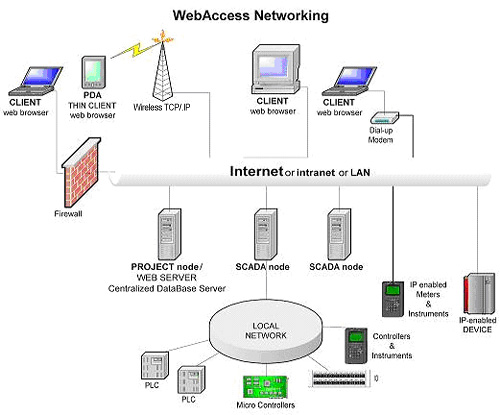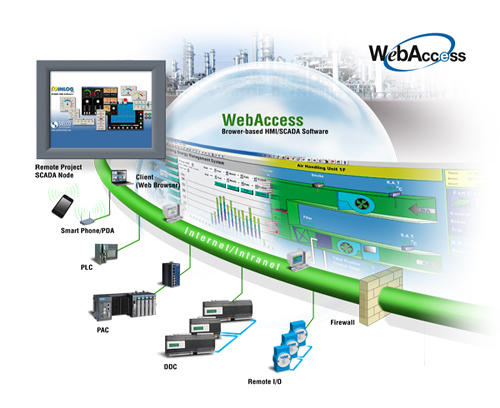Integrated Solutions for SCADA-based Applications
- Combining Hardware and Software to
Meet Increasing Market Trends
The term SCADA usually refers to centralized systems which monitor and control entire sites, or complexes of systems spread out over large areas (anything from within an industrial plant to across a country). Most control actions are performed automatically by Remote Terminal Units or by Programmable Logic Controllers. Host control functions are usually restricted to basic overriding or supervisory level intervention. For example, a PLC may control the flow of cooling water through part of an industrial process, but the SCADA system may allow operators to change the set points for the flow, and enable alarm conditions, such as loss of flow and high temperature, to be displayed and recorded. The feedback control loop passes through the RTU or PLC, while the SCADA system monitors the overall performance.
SCADA's history is rooted in distribution applications, such as power, natural gas, and water pipelines, where there is a need to gather remote data through potentially unreliable or intermittent low-bandwidth/high-latency links. SCADA systems use open-loop control with sites that are widely separated geographically.
Trends in SCADA
There is a trend for PLC and HMI/SCADA software to be more "mix-and-match". In the mid 1990s, typical DAQ I/O manufacturers supplied equipment that communicated using proprietary protocols over RS-485. End users who invested in a particular vendor's hardware solution often found themselves restricted to a limited choice of equipment when requirements changed. To mitigate such problems, open communication protocols such as IEC 60870-5-101, IEC 61850, DNP3 serial, and DNP3 LAN/WAN became increasingly popular among SCADA equipment manufacturers and solution providers alike. Open architecture SCADA systems enabled users to mix-and-match products from different vendors to develop solutions that were better than those that could be achieved when restricted to a single vendor's product offering.
Towards the late 1990s, the shift towards open communications continued with individual I/O manufacturers as well, who adopted open message structures such as Modbus RTU and Modbus ASCII (originally both developed by Modicon) over RS-485. By 2000, most I/O makers offered completely open interfacing such as Modbus TCP over Ethernet and IP.
SCADA systems are coming in line with standard networking technologies. Ethernet and TCP/IP based protocols are replacing the older proprietary standards. Although certain characteristics of frame-based network communication technology (determinism, synchronization, protocol selection, environment suitability) have restricted the adoption of Ethernet in a few specialized applications, the vast majority of markets have accepted Ethernet networks for HMI/SCADA.
With the emergence of software as a service in the broader software industry, a few vendors have begun offering application specific SCADA systems hosted on remote platforms over the Internet. This removes the need to install and commission systems at the end-user's facility and takes advantage of security features already available in Internet technology, VPNs and SSL. Some concerns include security, Internet connection reliability, and latency.
SCADA systems are becoming increasingly ubiquitous. Thin clients, web portals, and web based products are gaining popularity with most major vendors. The increased convenience of end users viewing their processes remotely introduces security considerations. While these considerations are already considered solved in other sectors of internet services, not all entities responsible for deploying SCADA systems have understood the changes in accessibility and threat scope implicit in connecting a system to the internet.
SCADA Software and Hardware Components
SCADA systems are an extremely advantageous way to run and monitor processes. They are great for small applications such as climate control or can be effectively used in large applications such as monitoring and controlling a nuclear power plant or mass transit system.
SCADA can come in open and non-proprietary protocols. Smaller systems are extremely affordable and can either be purchased as a complete system or can be mixed and matched with specific components. Large systems can also be created with off the shelf components. SCADA software can also be easily configured for almost any application, removing the need for custom made software development.
In an effort to meet this trend, Advantech has been working to provide combined hardware and software solutions, providing added-value solutions to customers in a wide variety of markets. These solutions are tied together by WebAccess, Advantech’s renowned Browser-based HMI/SCADA software.
WebAccess Browser-based HMI SCADA Software
WebAccess is a browser-based software package for human machine interfaces (HMI), and supervisory control and data acquisition (SCADA). It is used to automate complex industrial processes for situations where remote operations are needed. All the features found in conventional HMI and SCADA software packages are available in a standard browser including Animated Graphics Displays, Real-time Data Control, Trends, Alarms and Logs.
Through a standard Web browser, users can view and control automation equipment used in industrial, manufacturing, process and building automation systems. Data is displayed to users in real-time with dynamically updated graphics using full-motion animation..

Robust Hardware to Meet Diverse SCADA Applications
Advantech also provides a variety of hardware integrated with WebAccess, offering streamlined and efficient packages for its customers. The wide variety of hardware Advantech provides for these applications includes PACs, such as APAX-5570KW/CE, APAX-5571KW/CE and ADAM-5550KW; Embedded Automation Computers, like UNO-1100, UNO-2100, UNO-3000, UNO-3200, and UNO-4600 series, HMI devices including the entire TPC product line and WebLink & WebView platforms. Advantech also provides DVR (digital video recorder) systems such as DVS series, PVS series, and video surveillance capture cards that are all compatible with WebAccess.

|